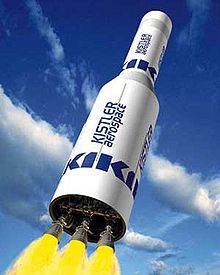Rocketplane Kistler

Rocketplane Kistler was an American space company based in Oklahoma City , which worked on the introduction of recyclable rockets for launching payloads into low earth orbits. The company emerged in 2006 from the merger of the companies Rocketplane Limited Incorporated and Kistler Aerospace and became known through participation in the Commercial Orbital Transportation Services program advertised by NASA . On June 15, 2010 insolvency proceedings were opened. In December 2011, all assets of Space Assets LLC were acquired and the new company Kistler Space Systems was founded.
Company history
The Kistler Aerospace branch was founded as a private company in 1993 by entrepreneurs Walter Kistler and Bob Citron. The company's idea was to develop an inexpensive commercial launch vehicle for low Earth orbit, which should be largely recyclable. However, it was not possible to win buyers for the missile type, so that the company repeatedly had financial problems due to the cost-intensive development. In February 2006, Kistler Aerospace was taken over by the competing company Rocketplane Limited Incorporated . At this point the development of the K-1 missile was already about 75% complete. Since then, both companies have been working under the common name of Rocketplane Kistler on the completion and introduction of reusable launch vehicles. The merger enabled Rocketplane Kistler to submit the design of the Kistler K-1 rocket for participation in NASA's COTS program.
NASA competition and COTS program
On January 18, 2006, NASA announced the program called Commercial Orbital Transportation Services for the transportation of equipment, goods and crews to the International Space Station (ISS). The aim was to find suitable private companies for the development and construction of launch vehicles. In August 2006, NASA announced that of more than 20 applicants, only SpaceX and Rocketplane Kistler were selected to participate in the program. Both companies should receive high financial subsidies from NASA according to the level of development of their spacecraft. Rocketplane Kistler was originally promised 207 million US dollars if the required demonstration flights of their design were successfully carried out between 2008 and 2010. In addition, the company has been promised to award contracts to supply the ISS in the event of the successful development of an operational transport system. Work on the K-1 rocket then became the company's sole project.
The K-1 missile
→ Main article: Kistler K-1
By introducing a largely reusable rocket, Rocketplane Kistler hoped to get considerably cheaper starts and thus a successful alternative to the cost-intensive disposable rockets. The main payload of the K-1 rocket, which has been under development since around 1990, was intended to be smaller satellites for low earth orbits. For the COTS program, the draft of the K-1 was revised and adapted to the requirements of NASA. A freight module was created that is supposed to transport around 2.7 tons of freight to the ISS. For docking with the ISS, it was planned to capture the rocket with the aid of the station's own robotic arm and dock it to a Common Berthing Mechanism on the American part of the station. This docking maneuver is also carried out by the Japanese H-2 Transfer Vehicle .
In November 2006, Kistler announced that Alliant Techsystems (ATK) had been selected as the main contractor for the construction of the K-1. The American company Aerojet selected modified engines of the commercially available Russian type Kuznetsov NK-33 to drive the rocket . The launch of the rocket was initially planned by Woomera in Australia. Both stages of the two-stage rocket are to return to earth after the payload has been deployed in earth orbit and land with the help of parachutes and airbags. The K-1 would have been the first completely reusable launcher in the world.
Financial problems
Even before participating in the COTS program, Rocketplane Kistler and its legal predecessor Kistler Aerospace had repeatedly struggled with financial problems. As a result, in September 2006, just one month after starting participation in the COTS program, the first appointments with NASA could not be kept. On request, NASA granted an extension of 30 days in order not to endanger the course of the project. In February 2007, Rocketplane Kistler presented a revised COTS contract, according to which private investors were to provide 500 million US dollars in addition to NASA funds. However, it was not possible to raise sufficient funds for the development of the K-1, so that there were again delays in the project. On September 7, 2007, NASA announced that Rocketplane Kistler would be excluded from the COTS program if the required appointments were not made within a final period of 30 days. In October, NASA announced the final expulsion of Rocketplane Kistler from the COTS program. Of the originally agreed funding of 207 million US dollars, only 32.1 million US dollars had been paid out by the time the contract was terminated. Rocketplane Kistler was then forced to lay off employees and cancel orders from suppliers. In June 2010, Rocketplane finally filed for bankruptcy.
swell
- ↑ http://www.kistler.co/newsinfo-main.html
- ↑ NASA announcement: NASA selects crew, cargo launch partners. www.spaceflightnow.com, August 18, 2006, accessed August 12, 2009 .
- ^ International Space Station Resupply. (No longer available online.) Rocketplane Kistler, archived from the original on November 21, 2013 ; accessed on August 12, 2009 .
- ↑ Rocketplane Kistler and ATK Announce Agreement for K-1 Launch Vehicle and COTS Program ( Memento of February 11, 2007 in the Internet Archive )
- ^ Brian Berger: NASA Gives Rocketplane Kistler Termination Notice. Space.com, September 7, 2007, accessed August 12, 2009 .
- ^ Andy Pasztor: Rocketplane Cuts Workforce As Financial Woes Mount. Wall Street Journal, August 23, 2007; accessed August 12, 2009 .
- ^ Jeff Foust: The gap in NewSpace business plans. The Space Review, July 12, 2010, accessed August 4, 2010 .
Web links
- Official website of Rocketplane Kistler (English)
- Rocketplane Kistler and COTS in Raumfahrer.net (2006)
- Bernd Leitenberger: The Kistler K-1 launcher
